
Hastings is a large seaside town and borough in East Sussex on the south coast of England, 24 mi (39 km) east to the county town of Lewes and 53 mi (85 km) south east of London. The town gives its name to the Battle of Hastings, which took place 8 mi (13 km) to the north-west at Senlac Hill in 1066. It later became one of the medieval Cinque Ports. In the 19th century, it was a popular seaside resort, as the railway allowed tourists and visitors to reach the town. Today, Hastings is a fishing port with the UK's largest beach-based fishing fleet. It has an estimated population of 92,855 as of 2018.

Kemptown is a small community running along the King's Cliff to Black Rock in the east of Brighton, East Sussex, England.

Volk's Electric Railway (VER) is a narrow gauge heritage railway that runs along a length of the seafront of the English seaside resort of Brighton. It was built by Magnus Volk, the first section being completed in August 1883, and is the oldest operational electric railway in the world, though it was not the first electric railway to be built. It was preceded by electrification of Miller's line in 1875, Werner von Siemens' 1879 demonstration line in Berlin and by the Gross-Lichterfelde Tramway of 1881, although none of these remain in operation.

St Leonards Warrior Square railway station is on the Hastings line in the south of England and is one of four stations that serve Hastings, East Sussex. It is 61 miles 55 chains (99.3 km) down the line from London Charing Cross. The station is operated by Southeastern but is also served by trains operated by Southern.

Eastbourne railway station serves the seaside town of Eastbourne in East Sussex, England. It is on the East Coastway Line. The station is managed by Southern, who operate all trains serving it. It is one of two railway stations in the town, the other being Hampden Park Station. There are also two other stations in the Eastbourne area, one being Pevensey & Westham, in nearby Westham, the other being Polegate.

The Pilot Field is a football stadium in Hastings, East Sussex. It is home to Hastings United who currently play in the Isthmian League, the club have used the ground since 1985 after the old Hastings United folded, having previously used the ground between 1920 and 1948. The current capacity stands at 4,050 although over 9,000 have been known to attend events in the past and the closure of the grass bank has decreased the capacity.

East Hill Cliff Railway, or East Hill Lift, is a funicular railway located in the English seaside town of Hastings. It provides access to Hastings Country Park via the East Hill, which overlooks the Old Town and Rock-a-Nore, an area to the east of Hastings. The line provides views over The Stade, home to the largest beach-launched fishing fleet in Europe.

The Blackhand Gorge State Nature Preserve is a 4-mile-long (6.4 km) sandstone formation through which the Licking River flows in Licking County, Ohio, United States. Located 12 miles (19 km) east of Newark near the tiny town of Toboso, 957 acres (387 ha) along the gorge were designated an Ohio Nature Preserve in 1975. The gorge is a capsule of Ohio transportation history, having hosted canal boats, steam railroads, electric interurbans, and automobiles through the years. It is named for the black hand petroglyph that was found on the cliff face by the first settlers to the area. Black Hand Sandstone is a resistant rock that also forms the backbone of the Hocking Hills region.

The West Hill Cliff Railway, or West Hill Lift, is a funicular railway located in the English seaside town of Hastings. It runs largely in tunnel, and provides access to Hastings Castle and St Clement's Caves from George Street, on the town's sea front. The West Hill overlooks the sea to the south, the Old Town to the east, and the current central business district of Hastings to the west.

Winkle Island is a traffic island at the heart of Hastings Old Town in East Sussex, England, in the United Kingdom. It is part of a unique area in Hastings called 'The Stade' and the stretch of shingle beach from which Hastings' famous fishing fleet has been launched every day for over a thousand years.

Hastings Old Town is an area in Hastings, England roughly corresponding to the extent of the town prior to the nineteenth century. It lies mainly within the easternmost valley of the current town. The shingle beach known as The Stade is home to the biggest beach-launched fishing fleet in Britain.

St Leonards West Marina is a disused railway station in the West St Leonards area of the borough of Hastings, East Sussex. Opened by the Brighton, Lewes and Hastings Railway in 1846 as part of what became the East Coastway Line, it was the first permanent station to serve the area and became part of a feud between two rival railway companies over access to nearby Hastings. Although ultimately inconvenient for local services, the station became an important goods railhead and the location of a motive power depot for locomotives working express services to London. The station was closed in 1967 and subsequently demolished, although in 2011 remnants of the down platform could still be seen.

The Stade is a shingle beach in Hastings Old Town, Hastings, East Sussex, England. It has been used for beaching boats for more than a thousand years. It is now home to Europe's largest fleet of beach-launched fishing boats.

Sussex is a historic county and cultural region in the south of England corresponding roughly in area to the ancient Kingdom of Sussex. It is bounded on the north by Surrey, north-east by Kent, south by the English Channel, and west by Hampshire, and is divided for local government into West Sussex and East Sussex and the city of Brighton and Hove. The city of Brighton & Hove was created a unitary authority in 1997, and was granted City status in 2000. Until then Chichester had been Sussex's only city. By convention, Chichester is Sussex's capital city and Lewes is Sussex's county town.

Black Rock is an area of undeveloped land located near Brighton Marina in the city of Brighton and Hove. It was previously the site of a swimming pool that was demolished in the 1980s.

West Hill is an area of Brighton and Hove, East Sussex situated on the east-facing hill rising west from Brighton railway station towards Seven Dials. The area is bounded by Dyke Road to the west, by the curve of the railway line and the station to the north and east, and by modern development along Queen's Road to the south-east.

The Gulf of Salwah is the southern portion of the Gulf of Bahrain. The Gulf of Salwah is a narrow bay separating the peninsula of Qatar from Saudi Arabia. It is bordered to the west by a well-vegetated shoreland containing palm trees and reed beds. To the east are low cliffs and hills, with sand dunes and salt flats at the southern end.

Hastings Fishermen's Museum is a museum dedicated to the fishing industry and maritime history of Hastings, a seaside town in East Sussex, England. It is housed in a former church, officially known as St Nicholas' Church and locally as The Fishermen's Church, which served the town's fishing community for nearly 100 years from 1854. After wartime damage, occupation by the military and subsequent disuse, the building was leased from the local council by a preservation society, which modified it and established a museum in it. It opened in 1956 and is now one of the most popular tourist attractions in the town and borough of Hastings. The building, a simple Gothic Revival-style stone chapel, has been listed at Grade II by English Heritage for its architectural and historical importance.

The geology of East Sussex is defined by the Weald–Artois anticline, a 60 kilometres (37 mi) wide and 100 kilometres (62 mi) long fold within which caused the arching up of the chalk into a broad dome within the middle Miocene, which has subsequently been eroded to reveal a lower Cretaceous to Upper Jurassic stratigraphy. East Sussex is best known geologically for the identification of the first dinosaur by Gideon Mantell, near Cuckfield, to the famous hoax of the Piltdown man near Uckfield.

The Hastings Miniature Railway is a 10+1⁄4 in gauge miniature railway located on the seafront at Hastings, a seaside resort, town, and ancient cinque port, in East Sussex, England. Opened in 1948, it remains a popular tourist attraction. The line was re-opened in the summer of 2011 after a period of reconstruction and restoration, which coincided with a forced closure of the eastern part of the line, to facilitate building work on a new art gallery adjacent to the railway.



















